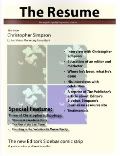Cultural marketing threatens Keebler Elves and Tetley Tea Folk
The following is a reprint of the Ad Nauseam column which appeared in the December 30, 2008 edition of the Metaverse Messenger.
While marketing is important, we should always keep in mind its cost to culture. News shows are cluttered with spots which amount to little more than promotions of consumer goods; snack food advertisement has been credited with the increase of obesity among children; and educational institutes have find themselves engaging in various degrees of product placement in return for funds.
But nowhere is the influence of marketing felt stronger than when the commodity being marketed is the culture itself. This can clearly be seen in the case studies of two separate cultures which, as a marketing device, turned to their own heritage.
“Admittedly, tea has always played a large and important role in our culture,” says Earl Bergamot, one of the Tetley Tea Folk’s most prominent citizens, “but over the last few decades it has grown out of all proportion. The only things tourists are interested in these days are the tea-related items: handcrafted tea-pots, coasters, strainers — that sort of thing. Sometimes they’ll pick up a couple of the ankle bells we wear for traditional dances, but only because they’ve seen us dancing on TV.”
Artisans who create the in-demand items find themselves doing a thriving business, and certainly no one is complaining about the much-needed infusion of foreign dollars into the economy. The downside, however, is that many of the other, and equally important, traditional art forms have gone into serious decline.
“Our religious artefacts have all but disappeared,” mourns Bergamot. “I think there are only two artists still producing black-velvet paintings. Our heritage is suffering.”
The second case study involves a culture forced to reinvent its history in order to disassociate itself from characteristics which may not be conducive to the marketing of its products.
“We’re supposed to be cute, ya know?” says Shop Steward Ernest J. Keebler of the Keebler elves; but the cigar-waving figure seated across from me in the office of a large cookie factory is a far cry from his TV persona frequently shown gently encouraging his helpers.
The Keeblerites came into their cookie heritage many centuries back. Representing the losing faction in a civil war fought over labor issues in 1345 AD, they were exiled from the North Pole and forced to start a new society further south. But while they had little in the way of resources, they refused to compromise their most precious principle. “We work, we get paid!” says Ernest, summing up the Keebler philosophy. “It’s as simple as that. We didn’t give in to the f---ing fat man in the red suit and we’re sure as hell not going to give in to anyone else!”
Upon founding their new country in 1347, they were then faced with the challenge of finding a new line of work.
“All we knew was, like, wooden toys, see?” says Ernest, laughing. “Then when the plague started breaking out all over Europe we figured: what the hell — let’s make cookies.” Starting from scratch was no easy task, however.
“Of course, we didn’t know the first thing about cookies, and all our early recipes called for a lot of saw-dust.” Ernest leans forward conspiratorially. “We still make the saw-dust cookies,” he says with a smile. “We just sell ‘em to the dorks in the health food store. It’s amazing what those guys will buy!”
But public image isn’t the only problem facing the Keeblerites. Once a year, after the filming of his popular television, the Cookie Monster beats his annual, month-long retreat to the Keebler valley.
“Man, oh man!” groans Ernest. “When that guy hits town we all know it. And when he brings that a--hole friend of his, Barney, it takes us a full month just to fix the place up again.”
While solutions may yet be a long way off, simply acknowledging the problem is a step in the right direction. The question is, will the cultures be around long enough to benefit?
The pathos of the situation was brought home to me at the end of my interview with Tetley Tea’s Earl Bergamot. The solemn little man took me into a local church and pointed out an empty alcove. “Until it was broken a few years ago,” he said, “there used to be a beautiful plaster-cast bust of Elvis in that space. It still hasn’t been replaced.”
He shook his head sadly. “Our culture is dying.”






0 comments:
Post a Comment